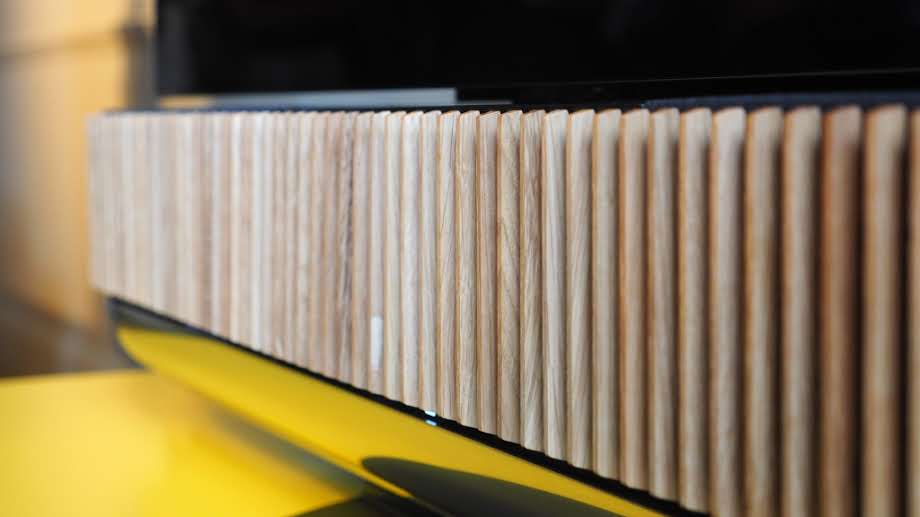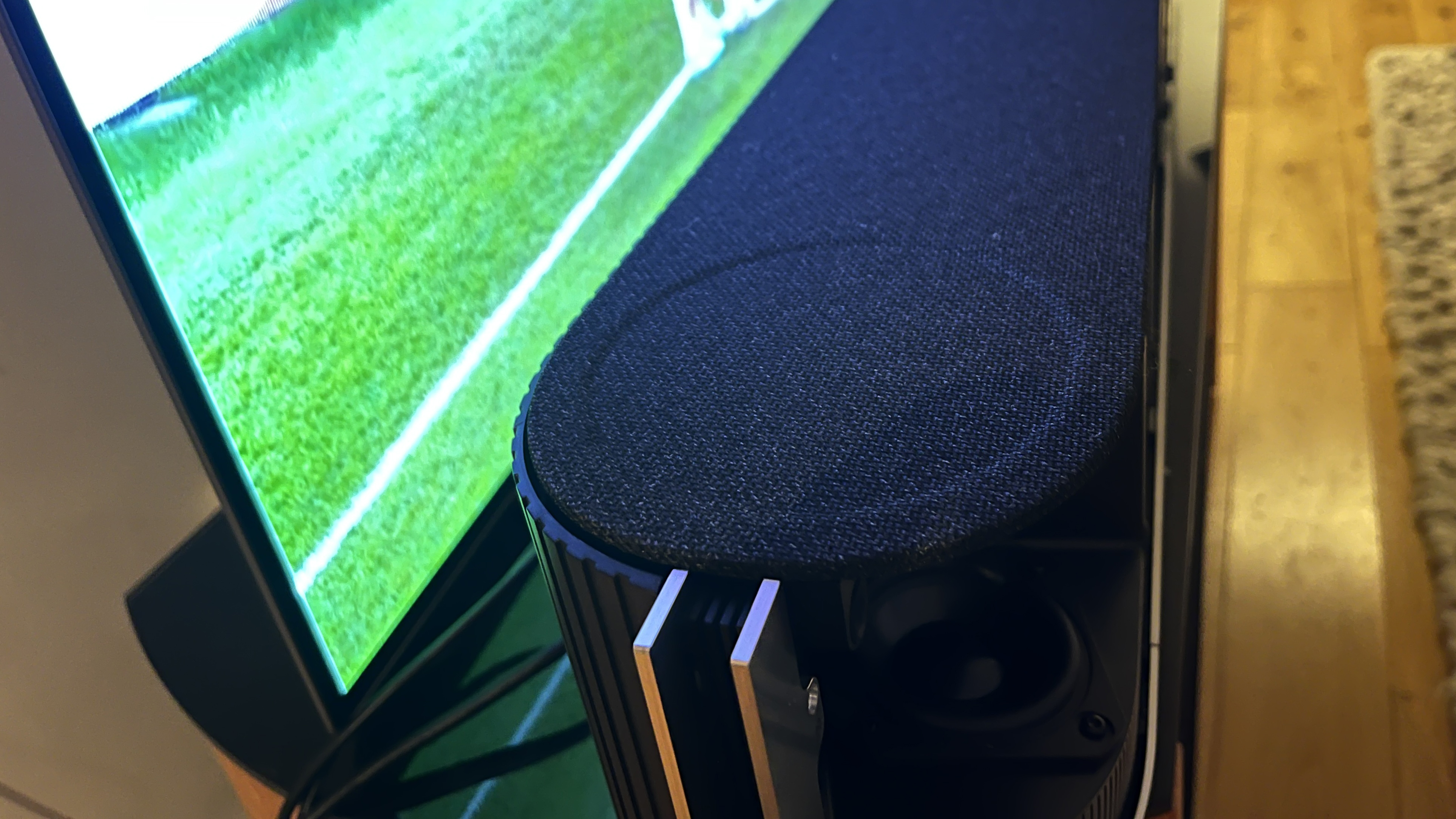Bang & Olufsen Beosound Theatre review: all singing, all dancing?
Is the priciest soundbar you've probably ever seen also the best soundbar you've probably ever heard? Here's our Beosound Theatre review to lift the curtain on all...



It’s easy (and tempting) to dismiss the Bang & Olufsen Beosound Theatre as an overpriced irrelevance. In truth, though, it’s a profoundly impressive performer with a whole stack of positives to its sound. If you can justify the outlay, it’s an admirable device in many respects.
-
+
Expansive, forthright, insightful and thoroughly enjoyable sound
-
+
Constructed and finished without compromise
-
+
Great selection of control options
-
-
Even at its cheapest it’s very expensive
-
-
Not as Dolby Atmos-y as you’d hope/expect
-
-
Physically imposing
Why you can trust T3

Rely on Bang & Olufsen to take a good idea and run with it. The concept of the Dolby Atmos/spatial audio soundbar is not a new one, and neither is its ‘premium’ version - but the idea of a Dolby Atmos soundbar that costs as much as installing an actual, physical 7.1.4-channel audio system in your home has not been countenanced. Until now.
And because this is Bang & Olufsen we’re talking about, the look of the Beosound Theatre gets about as close to justifying the asking price as is possible without it actually being rolled in Swarovski crystals. But still, this is daft money for a soundbar, isn’t it? Or does the Beosound Theatre actually do the Very Unlikely Indeed and actually justify its asking price as being one of the best soundbars?
Bang & Olufsen Beosound Theatre: Price & Release Date

The Bang & Olufsen Beosound Theatre is on sale now, and in the United Kingdom it’ll set you back anywhere between £5590 and £6390, depending on the sort of finish you fancy. That’s if you intend to position it on its wall-mount or little central foot - a motorised wall-bracket or motorised floorstand attracts additional outlay. In America it costs between $6890 and $7990, while in Australia you’re looking at AU$11,860 - AU$13,650.
Some context is important here, of course. Until now, the Sennheiser Ambeo stands as both the most impressive and the most expensive Dolby Atmos soundbar T3.com has tested - it costs £2199 and we called its audio performance ‘unsurpassed’. So all the Beosound Theatre has to do is surpass the Ambeo’s performance by, oh, a factor of three or thereabouts and it’ll justify the asking price. Looks simple enough when it’s written down, doesn’t it?
Bang & Olufsen Beosound Theatre review: features & what’s new?

As seems only reasonable for a soundbar with an asking price that’s such a big number, there are plenty of other big numbers attached to the Beosound Theatre’s features.
Take speaker drivers, for instance - in order to deliver the Dolby Atmos 7.1.4 sound it’s capable of decoding, there are a total of twelve speaker drivers here. Two 165mm bass drivers flank a central 133mm coaxial midrange driver with a 25mm tweeter in its throat. Further out towards the ends of the soundbar are two more 25mm tweeters above 76mm midrange drivers, and in a cavity at each end there are two outward-facing 64mm full-range drivers with two more 64mm full-range drivers facing upwards and firing through the knitted acoustic cloth that covers much of the top of the soundbar.
Power is similarly considerable. Each of the bass drivers is in receipt of 100 watts of Class D power, while the other 10 drivers enjoy 60 watts each. A total of 800 watts should, by any metric, prove adequate for even the largest listening rooms.
Get all the latest news, reviews, deals and buying guides on gorgeous tech, home and active products from the T3 experts
As well as full-on Dolby Atmos soundtracks, the Beosound Theatre can handle Dolby TrueHD and Dolby Digital Plus soundtracks. There are a number of customisable listening modes available via the control app, too, and an advanced ‘bass management’ system. And to make sure it’s working your listening space to best advantage, the soundbar is supplied with a calibration mic on a tripod - simply plug it into the 3.5mm socket on the fascia and the app will do its thing. Multiple positions can be assessed and memorised, so you should be getting everything the Bang & Olufsen has to offer no matter where you’re sitting.

More big numbers apply when the subject of connectivity comes up. Physical inputs are in a recessed, covered rear panel with some Velcro-based cable-management available. There are four HDMI sockets, one of which is 4K@120Hz and eARC enabled, and some Ethernet switching with four ports (one of which is specifically assigned for LG OLED TV connection, when integrated control via the B&O app becomes available). And there are connections for up to eight Beosound Powerlink speakers - the Theatre can also connect to the same number of wireless Powerlink speakers too, if you’re determined to build the largest system of Beosound speakers possible.
There’s further wireless connectivity available, of course. As well as dual-band Wi-Fi and Bluetooth 5.1, the Beosound Theatre supports Apple AirPlay, Chromecast and Spotify Connect. Bang & Olufsen is serious when it suggests the Beosound Theatre is as much a music device as it is a movie speaker.
Bang & Olufsen Beosound Theatre review: Performance

There’s plenty to admire about the way the Beosound Theatre sounds, and very little to take issue with. But this is a Dolby Atmos soundbar, and so we may as well start with that aspect of its performance and then move on to the good stuff.
There’s just not all that pronounced an Atmos effect to the way the Theatre delivers an Atmos soundtrack. It’s able to generate a wide, impressively deep soundstage on which to position all of a movie’s sonic elements - but it struggles to create meaningful height. Certainly if you’re using a 55-inch TV (which, as the soundbar’s design dictates, is really as compact a screen as is realistic) the Theatre can’t position sound above its top bezel. So the effect is underplayed and the vertical aspect of the soundstage rather curtailed.
In pretty much every other respect, though, the Bang & Olufsen varies between ‘impressive’ and ‘very impressive indeed’.
You certainly won’t hanker after a dedicated subwoofer. B&O is claiming the Theatre extends down to 28Hz, and when you get an earful of the deep, detailed, controlled and substantial bottom-end this soundbar can generate, it actually seems likely. Low-frequency stuff has body and punch, lovely straight edges at the attack of sounds and a whole heap of information regarding timbre and texture. The weight and control of bass sounds here creates real momentum, and the amount of variation the Beosound Theatre can identify makes each low-end event distinct and individual.

At the opposite end of the frequency range, the Theatre attacks with brisk determination - treble sounds are fleet and substantial, with nicely judged bite never tipping into hardness. Again, detail levels are high and intentions are never in doubt.
In between, the midrange arrangement does sterling work with dialogue. It projects well, it carries an absolute stack of detailed information about tone, and it makes every speaker sound like a characterful individual. There’s a directness and a positivity about the way the Theatre delivers midrange information that puts dialogue front-and-centre - even during the most climactic and/or chaotic moments.
The entire frequency range is integrated smoothly - no mean feat when you’re talking about a dozen speaker drivers - and tonality is convincing from top to bottom. Even though the Beosound Theatre can summon unlikely low-frequency presence, it never sounds overblown or in any way pleased with itself.
As 800 watts of power strongly suggests, the Bang & Olufsen has no problem dispatching even the most significant dynamic shifts without breaking audible sweat. The distance it can put between ‘sneaking away having planted a device’ and ‘device detonating in a big way’ is considerable - and it does so without sounding in any way forced or stressed, and it does so with absolute control. That same surfeit of power goes some way towards helping the Theatre deliver the low-key dynamic variations in speech or musical instruments in full, too.
Bang & Olufsen Beosound Theatre review: design & usability

As is customary with Bang & Olufsen products, ‘design’ plays a big role in the Beosound Theatre. And as is equally customary, options are numerous.
The Beosound Theatre is designed to accompany 55in, 65in or 77in TVs - and if you use the supplied wall-mount to position it beneath your TV, the considerable depth of the soundbar is effectively halved by the way the screen is positioned. Bang & Olufsen supplies a selection of aluminium ‘wings’ that form the ends of the Theatre - so if you want to position a bigger TV above it, simply swap the wings and the soundbar magically grows in order to match your television’s width. And when you consider the Theatre is 197 x 1222 x 157mm (HxWxD) when in ‘55in’ guise, it becomes apparent that a) this is a large device even when it’s at its smallest, and b) if you want to put it on a surface in front of your TV then your telly had better be on stilts.

Bang & Olufsen hasn’t really attempted to mitigate the bulk of the Beosound Theatre, but it has at least attempted to make it as decorative and furniture-like as possible. So this big, vaguely boat-shaped device is available with its aluminium elements either ‘natural’, ‘black anthracite’ or ‘gold tone’ in colour, while the front of the device can feature ‘oak’, ‘light oak’ or ‘dark oak’ wooden slats with ‘dark grey melange’ fabric as an alternative. There’s nothing discreet about the Beosound Theatre - quite the opposite, in fact - but the design and the finish options serve to make it appear business-like but mildly decorative at the same time.
Control options here are both numerous and well-implemented. With an appropriate connection made to the TV, volume can be controlled from the screen’s remote control. On the Theatre's top surface there's a suite of proximity-sensing touch-controls set into a section of unhelpfully reflective but unarguably tactile glass. The Bang & Olufsen control app is just as stable, logical and comprehensive here as it is in every other instance. Or you can add yet further to your outlay by shelling out for the Beoremote One remote control.
Bang & Olufsen Beosound Theatre review: Verdict

Yes, it’s too expensive. Yes, it’s too big. Yes, it’s been designed by someone who should have had their pencils confiscated halfway through the process. And no, it doesn’t deliver a Dolby Atmos soundtrack with as much conviction as an alternative soundbar costing less than half of this money. But nevertheless, there’s plenty to like - admire, even - about the Bang & Olufsen Beosound Theatre. It sounds big, confident and utterly convincing, it almost looks like the money’s-worth, and it’s shorthand for just what a well-off and discerning individual its owner is.
Also consider
We’ve invoked the Sennheiser Ambeo before now, and we’re about to do it again. It remains the best pound-for-pound Dolby Atmos soundbar you can buy - and while its aesthetic is made to look a bit lumpy and pedestrian by the Beosound Theatre, its performance remains an absolute paradigm. Unless your speaker needs to make as profound a visual as it does a sonic statement, the Ambeo remains the weapon of choice.
Simon Lucas is a freelance technology journalist and consultant, with particular emphasis on the audio/video aspects of home entertainment. Before embracing the carefree life of the freelancer, he was editor of What Hi-Fi? magazine and website – since then, he's written for titles such as Wired, Metro, the Guardian and Stuff, among many others. Should he find himself with a spare moment, Simon likes nothing more than publishing and then quickly deleting tweets about the state of the nation (in general), the state of Aston Villa (in particular) and the state of his partner's cat.
